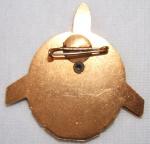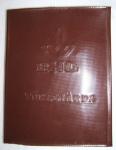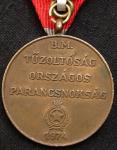-
Posts
4,807 -
Joined
-
Last visited
-
Days Won
12
Content Type
Profiles
Forums
Blogs
Gallery
Events
Store
Everything posted by Gordon Craig
-

Hungary T?RZSG?RDA IGAZOLV?NY
Gordon Craig replied to Gordon Craig's topic in Central & Eastern European States
-

Hungary T?RZSG?RDA IGAZOLV?NY
Gordon Craig replied to Gordon Craig's topic in Central & Eastern European States
The next pin is very large for these type of pins. It measures 43mm (1 3/4") by 43mmThe quality is also superior to most pins I have seen. Perhaps it is of better quality because it is for MAL?V, the state airline, and would have been prominently displayed on one of the crew's uniforms. Unfortunately, there was no documentation with this pin and I really would like to have seen that. -

Hungary T?RZSG?RDA IGAZOLV?NY
Gordon Craig replied to Gordon Craig's topic in Central & Eastern European States
-

Hungary T?RZSG?RDA IGAZOLV?NY
Gordon Craig replied to Gordon Craig's topic in Central & Eastern European States
-

Hungary T?RZSG?RDA IGAZOLV?NY
Gordon Craig replied to Gordon Craig's topic in Central & Eastern European States
Ulsterman, Haven't had time to sort through my pins yet. Too much new stuff to buy! Here are some a additional T?RZSG?RDA items that I picked up in the last couple of days. First up is a T?RZSG?RDA book from a company with the initials BHG on the cover which stands for BELOIANNISZ HIRAD?STECHNIKAI GY?R. I haven't done any research on this firm yet and bought the book and badges because the book has several pages in it that refer to these types of pins and it might contain some useful information once I have time to look at it. There are two pins inside the book pinned through the plastic cover. One is gold and the other black. There is nothing on them to indicate how many years they were awarded for which is unusual. Perhaps that will come to light when I translate the book but nothing jumps out at me from the pages I have looked at so far. Here are the pictures of the book. -

Hungary Hungarian Firemen's Medals
Gordon Craig replied to Gordon Craig's topic in Central & Eastern European States
Zsolt, I was sure I had replied to your post earlier today buit I don't see it in this thread. It will be next week before I will know if we have a trade or not. I'll know by next Tuesday. Regards, Gordon -

Hungary Hungarian Firemen's Medals
Gordon Craig replied to Gordon Craig's topic in Central & Eastern European States
-

Hungary Hungarian Firemen's Medals
Gordon Craig replied to Gordon Craig's topic in Central & Eastern European States
Zsolt, Thanks for reminding me who the photos belong to. I had put your photo in my archives but neglected to keep track of where I had found it or I would have advised in the post where it came from. Thanks for your understanding. Here is a picture of the 1974 30 year Bronze Medal with Wreath for a Professional Firefighter from my collection. Regards, Gordon -

DDR Question about cases .
Gordon Craig replied to Grant Broadhurst's topic in Germany: Post 1945: Bundesrepublik & DDR
Uwe, Thanks for the info. Collectors outside of Germany don't see that many variations in cases. Nice to know there are that many. Regards, Gordon -

DDR Question about cases .
Gordon Craig replied to Grant Broadhurst's topic in Germany: Post 1945: Bundesrepublik & DDR
Grant, I've never seen one in a black lined case. It looks as though the interior of the red lined case is recessed for the award but the black interior is not. The interior should be recessed for this award. Are the cases themselves the same? IE the same vintage/time frame? If the balck interior is not recessed to fit the shape of the award I would say there is something wrong here. Regards, Gordon -
Ulsterman, Interesting post. I do not recognize the badge pinned above his right breast pocket. The only award I can be sure of on his tunic easily is the left breast pocket which is for the Grand Cross for the Order of Merit for the Hungarian Republic, Military Grade. Only 15 Grand Crosses can be awarded annually. We'll work on the rest but some of the ribbons are hard to make out. Thanks very much for posting this interesting picture. Regards, Gordon
-

Hungary Hungarian Firemen's Medals
Gordon Craig replied to Gordon Craig's topic in Central & Eastern European States
-

Hungary Hungarian Firemen's Medals
Gordon Craig replied to Gordon Craig's topic in Central & Eastern European States
I have something to add here. A Bronze medal with wreath for the Volunteer Firemen for the 1974 to 1990 period. I'll post the obverse and the reverse as both differ from the 1958 version. The 30, 40 and 50 year medals were dated 1974 on the reverse. I have not seen a medal in the 5 to 20 year series dated 1974. I do not own this medal. This is a file picture from my archives. I do own a Bronze medal with wreath for the Professional Fireman. Regards, Gordon -

Hungary Hungarian Firemen's Medals
Gordon Craig replied to Gordon Craig's topic in Central & Eastern European States
FireMedals, Since Zsolt hasn't answered I'll give it a go. There may be some difficulty in what is said in this thread because of language problems. Basically, the medals we are dealing with here are for Professional Firemen and for Volunteer Firemen. They have nothing to do with men who may have been employed by firms to act as firemen. Don't be confused by Zsolt's use of the term "company". When he uses that term he appears to be talking about both Volunteer Firemen and Professional Firemen who were organized into "companies" at their individual locations. As you note, awarding the medals is done by the BM (short form) or Minisrty of the Interior. Many of the Firebrigade medals are the same except for the year on the back. You specifically mentioned 1958. Something we haven't covered yet but will get into later. ?VES? does translate as "years". V?LLALATI T?ZOLT?I SZOLG?LATERT? on the medals would refer to Professional Firemen not men who worked for a specific firm. ?NKENTES T?ZOLTOI SZOLG?LAT?RT (often abreviated to OT) on the medals refers to medals awarded to Volunteer Firemen. The first award was for five "V" years of service moving on to the others for continuous service beyond those 5 years. I have never come across any reference to a "Firepolice" in Hungary. Ulsterman has asked about the term "Fire Prevention Service". In the English language material we were given at the Fireman's Museum the term "Fire Prevention" was used a lot to describe the work of the Fire Brigade when actually fighting fires. It is difficult to judge from this material if there is a separate group within the Fire Brigades who concentrate on Fire Prevention versus Fire Fighting or not but I doubt it. Fire Prevention usually forms a large part of the work done by Fire Brigades no matter what country you look at. There are two different types of collar insignia worn during the period we are studying and one of the English speaking firemen we talked to at the museum indicated that those with the firetruck on their collars were fire fighters while those wearing the other symbol were involved in fire prevention. As I said earlier, I am not sure this is a fact or just a misunderstanding in translating Hungarian to English. Something still to be worked out. Regards, Gordon -

Hungary Hungarian Firemen's Medals
Gordon Craig replied to Gordon Craig's topic in Central & Eastern European States
Zsolt, Thanks for your great explanation of the Fireman's medals. I would like to add one more comment here. The medal pictured in this post is numbered on the back with the number of the badge worn by the fireman it was presented to. Regards, Gordon -

Hungary Miners' badges
Gordon Craig replied to Ulsterman's topic in Central & Eastern European States
Zolt, Thanks for your comments. I knew they were Torzsgarda pins but didn't bother translating the names on the badges. I guess that I should have. Regards, Gordon -

Hungary Munkasor Dress Tunic
Gordon Craig replied to Gordon Craig's topic in Central & Eastern European States
Charles, The Oklevel I have for this award is dated 1969 and was given out as a celebration of the 24th year since the liberation of Hungary. I think that probably answers the question but it would really be nice to have some contact with someone who had been in the Munkasor. Regards, Gordon I need to modify slightly what I said here earlier. The Oklevel was awarded for good service etc, although it does not specify five years of service, during the celebration of the 24th year since the liberation of Hungary. Not specifically to celebrate the 24th anniversary. -

Hungary Munkasor Dress Tunic
Gordon Craig replied to Gordon Craig's topic in Central & Eastern European States
Dan, There is one available at the moment. One of only two that I have seen. I have been debating about buying it and you have just made up my mind for me. I'll pick it up for you today and we can dsicuss price later. Regards, Gordon Charles, Re the "Five Year Itch" star. My case does not have the inscription on the top so it would have been an "at a boy" award. I think I'll save posting mine until I get back next week as I now have an award document for one. Cheers, Gordon -
Order of Victory, If I understand correctly, you recognize the badge associated with this document but do not know what the purpose of the document is. Correct? If so, here is my answer. 1-The carrying document pictured above allows the wearer of this DDR award to prove, should they be asked to do so, that they are entitled to wear it. Regards, Gordon
-

Hungary Munkasor Dress Tunic
Gordon Craig replied to Gordon Craig's topic in Central & Eastern European States
Ulsterman, Yes this is the tunic for the Workers Militia. I suspect, as with similar organizations in other Communist controlled states, that this type of tunic was only worn by full time functionaries in the Militia. Control was held by the party and they were a large armed force. How effective they would have been is another question. You rarely see these tunics in pictures. Normally just the workers type dress with the short jacket. The Kivalo badge was not awarded for 5 years service. There was another star shaped badge for that purpose. I think I've posted it somewhere else on the forum. If I have time before we leave for Prague tomorrow I'll try and post a picture of the one in my collection. In the meantime here is one in wear from a file picture. Regards, Gordon -

Hungary Hungarian Firemen's Medals
Gordon Craig replied to Gordon Craig's topic in Central & Eastern European States
Rick, After a few days of staring at these pictures of ribbons and medals, plus looking at the medals in my collection, I have come to some possible conclusions. 1-The 5, 10, 15. and 20 year medals were originally produced with the straight hangers and the 30, 40 , and 50 year medals were originally produced with the triangular ribbon hanger. The book we use for reference that we refere to as the "Blue Bible" was printed in 1979 and shows both series 5 to 20, and 30 to 50 years with a triangular ribbon. The medals depicted in this book are only line drawings so not 100% conclusive. 2- We know that there are medals in the 5 to 20 year series that have triangular ribbons. There are sufficient of them out there to prove they authentic. 3- Since the triangular ribbons are considered authentic on the 5 to 20 year series we can only conclude that the ribbon style was changed sometime prior to 1979. Thanks for your question. The more I have stared at the pictures to resolve your question the more things in them I have noticed. Learned a lot that way! Regards, Gordon -

Hungary Munkasor Dress Tunic
Gordon Craig replied to Gordon Craig's topic in Central & Eastern European States
-

Hungary Munkasor Dress Tunic
Gordon Craig replied to Gordon Craig's topic in Central & Eastern European States















